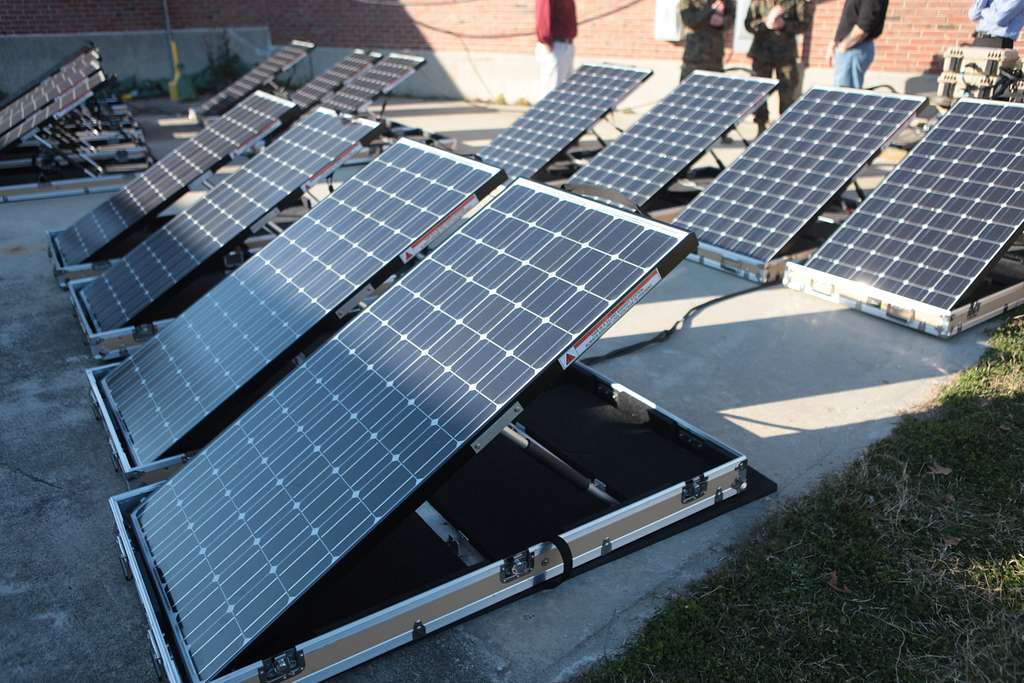Installing solar panels on your roof is generally more cost-effective because it leverages the structural integrity of your already existing rooftop, eliminating the need for a separate foundational structure. Moreover, roof-mounted solar systems are space-saving, as they don’t require additional square footage on your property. On the other hand, placing solar panels on the ground occupies a larger area, but the benefit is that they are more easily accessible for tasks such as installation and maintenance. Additionally, ground-mounted systems offer you enhanced flexibility in adjusting the angle and direction of the solar panels, which can optimize energy production.
After you’ve carefully selected your solar panels, the next critical step is to evaluate the most suitable mounting solution that aligns with your residential layout, financial constraints, and specific energy consumption requirements.
You have two primary choices when it comes to the method of mounting your solar panels: systems that attach to the roof and those that are anchored at ground level. Roof-mounted systems are designed to attach securely to the brackets that are installed on the top of your home. In contrast, ground-mounted systems are constructed with their own foundational structure, which is set at the surface of the ground. To better understand the differences, please refer to the illustrative images provided below for a side-by-side comparison.
Each type of mounting system comes with its own set of advantages and disadvantages, and the optimal choice may vary depending on the specific requirements and characteristics of your solar installation project. In this article, we will delve into the intricacies of both options, laying out our top recommendations for the most efficient solar panel mounting solutions.
We aim to provide you with an in-depth analysis, offering valuable insights into the factors we consider when advising our clients on whether a roof-mounted or ground-mounted racking system would better serve their needs.
But before we dive into the nitty-gritty details, here’s a brief overview to set the stage:
| Ground mounted solar panels | Roof-mounted solar panels |
| Pros: Convenient for hands-on access and inspectionSimpler to maintain and keep cleanLess complex when it comes to diagnosing and fixing issuesMore robust racking structure as a wholeFlexibility in system layout; not restricted by the roof’s geometryLower panel temperatures contribute to increased energy yieldElimination of the need to dismantle the panels for roof replacement tasks Cons: Installation demands greater manual effort and timeHigher costs associated with the overall installation processNecessitates a more extensive range of components and hardwareThe process of obtaining necessary permits comes at a higher costOccupies a larger footprint on your propertyVisual appeal may not be universally appreciated | Pros: More cost-effective overallLess material required for the installation processReduced labor costs associated with installationOptimizes otherwise unused rooftop spaceFacilitates a smoother permitting process Cons: Challenging to reach, particularly if dealing with a steep or slick roofComplicated diagnostic and repair processElevated panel temperatures can result in diminished energy outputLimited rooftop space restricts the system’s sizePotential for inconvenience should roof replacement be needed during the solar panel’s lifespan, possibly requiring a second installationDrilling into the roof structure has the potential for causing water infiltration damage |
Advantages for Those Using Both Off-Grid and Grid-Connected Systems
The ideal tilt isn’t the only thing that contributes to the efficiency of ground-mounted solar arrays. Their elevated position off the ground enables improved airflow and cooling, thereby increasing your panels’ energy output.
Most solar panels are calibrated with a temperature of around 25°C in mind, which corresponds to an average sunny day. When temperatures rise above this, the panels tend to operate less efficiently, resulting in a 10-25% reduction in electrical output. The semiconductors face increased resistance, hindering the flow of electricity, similar to how water flow is restricted when you squeeze a hose.
Superior airflow and cooling, therefore, optimize the operating conditions of your solar panels, making ground-mounted systems a beneficial choice.
Flexibility for Future Expansion
If your solar array is on your roof, you’ll likely face limitations in terms of space, restricting your array’s efficiency. And if your energy requirements evolve over time, expanding your existing rooftop system could be problematic.
Opting for a ground-mounted system offers you more latitude for future expansion, as long as your property has the available space. This flexibility allows for the addition of more panels later on, and most ground-mount setups are designed for easy extension.
This makes it straightforward to augment your energy supply should your property expand or if you find that your initial setup falls short.
Ease of Access
Accessibility is another compelling reason to opt for ground-mounted solar arrays. Solar installations often involve a fair amount of trial and error, particularly during the setup phase. Climbing onto the roof to troubleshoot can be inconvenient and potentially risky.
This aspect is especially important if your system includes accessories like microinverters and optimizers. Each of these components sits beneath a solar panel, making them challenging to replace on a rooftop system.
If a component in the middle of your array malfunctions, you’d need to dismantle multiple panels to rectify the issue. Having your system at ground level simplifies troubleshooting and makes routine maintenance like cleaning easier and safer. Pole mounts, suitable for snowy regions, can also be adjusted to maximize energy output and facilitate snow removal.
Downsides of Opting for Ground-Mounted Systems
Now let’s talk about the challenges that come with ground-mounted solar.
In essence, these systems are generally more complex and costly to install than their rooftop counterparts. If your main focus is achieving the highest return on your solar investment, then a roof-mounted system might be your best bet. Ground-mounted options will require a more involved permitting process and will consume more of your property’s available space, which you may wish to allocate for other purposes.
Permit Approval for Ground-Mounted Systems is more complicated and takes more time
Firstly, it’s important to note that your local governing body may take a more rigorous approach to the installation process for ground-mounted solar systems, as these are often seen as new structures on your property. Depending on your jurisdiction, you’ll need to liaise with the relevant authority to secure a building permit.
This can introduce additional steps to your installation process, including:
- Submitting detailed design plans for review
- Adhering to soil assessments and abiding by restrictions regarding the distance from your property lines
- Paying the requisite fees associated with obtaining the permit
- Impact on Property Space of Ground-Mount Systems
Another potential downside of opting for a ground-mounted solar system is that it consumes valuable land space. Installing panels on your roof, conversely, is a more discreet option and leaves your ground area free for other uses.
The issue of land use becomes less significant if your property is spacious. For those residing in rural areas, the likelihood of a ground-mounted system interfering with daily life is relatively low.
However, for homeowners with limited yard space, installing panels on the roof may be the only feasible option. In certain situations, a ground-mounted system might not be a possibility due to unavailable space.
When is Roof-Mount Racking Better?
The “best” mounting option is subjective and largely depends on a combination of your financial considerations, energy requirements, and lifestyle factors. A roof-mounted system is often a more suitable choice for those who:
- Aim to achieve the highest return on their solar investment
- Prefer a less complex installation process
- Have limited ground space available
- Wish to minimize initial expenditure
- Reduced Material and Labor Costs for Roof Installations
One appealing aspect of roof-mounted solar panels is the lower initial cost and quicker installation time.
When you opt for mounting solar panels on your roof, you’re essentially leveraging your existing roof structure, which eliminates the need for additional foundational work. This means you can sidestep complications such as soil testing, property line concerns, and the purchasing of extra materials like poles and concrete, thereby saving both time and money.
This arrangement is particularly beneficial for customers connected to the grid who are looking to make a wise financial move. Choosing a roof over ground installation can result in substantial savings upfront.
Roof-mounted solar systems are particularly beneficial in residential settings where ground space is limited. Whether you live in a condominium or in a densely populated suburb, your yard space is valuable for leisure activities, gardening, or children’s play areas. Roof-mounted solar panels optimize unused vertical space, leaving your yard uncluttered.
For those who own larger properties, installing solar panels on the roof can keep the land free for other uses, such as farming, raising animals, or additional constructions. It also keeps the landscape aesthetically pleasing by avoiding the clutter of ground-mounted systems.
Enhanced Insulation & Protection
A lesser-known advantage of roof-mounted systems is the added protection and insulation they provide to your roof. Solar panels shield your roof from UV radiation, wind, and precipitation. They can also offer thermal insulation. A study by experts suggests that solar panels can keep a roof approximately 5°C cooler, resulting in an average savings of about 5% on cooling costs, on top of the savings from the solar energy generated.
Simplified Permitting
Roof-mounted solar systems offer a more straightforward permitting process. You’ll mainly need to show that your roof structure is sound and that your electrical systems are up-to-date. Because you’re not adding a new structure to your property, the permitting process is quicker and less complicated.
Drawbacks to Consider
Despite the advantages, there are some challenges and limitations with roof-mounted solar systems:
- Limited Accessibility: The height of roof-mounted systems makes them less accessible for maintenance and troubleshooting.
- Suboptimal Efficiency: Depending on your home’s orientation and the pitch of your roof, it may be difficult to position the panels for maximum solar gain.
- Space Constraints: Your roof may have limited space due to features like chimneys or vents, reducing the number of panels you can install. It can also limit your options for future system expansion.
- Factors to Weigh
Before choosing a roof-mounted system, here are some crucial questions to consider:
- Roof Age: Given that both roofs and solar systems have similar lifespans, it’s efficient to install them simultaneously. If your roof is older, you may need to consider a replacement or at least ensure that it’s in good condition to support the additional weight of the solar panels.
- HOA Guidelines: Some Homeowners Associations (HOAs) may have restrictions on solar panel installations. It’s crucial to check their guidelines before proceeding.
- Electricity Costs: The upfront investment in solar panels can be significant, and the rate of return largely depends on your electricity consumption and local electricity rates. Assessing these can help you decide if the investment makes financial sense for you.
By carefully considering these points, you can make a well-informed decision about whether a roof-mounted solar system is the best fit for your energy needs and lifestyle.



